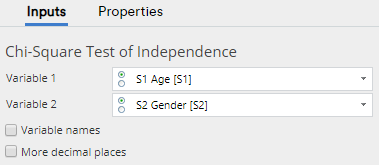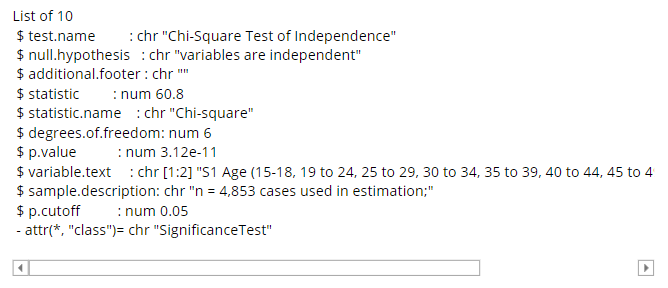Test - Chi-Square Test of Independence
Tests for independence between a pair of categorical variables. Any non-categorical variables that are supplied will be treated as categorical, that is to say, cases with the same value are treated as being in the same category, and date variables are categorised by period.
How to run this test
- Select Create > Test > Chi-Square Test of Independence.
- Specify the variables to use under Inputs > Variable 1 and Inputs > Variable 2
- Adjust the options (noted below)
You should use numeric variables as inputs. If you use categorical or ordinal variables, they will be coerced to numeric based on their values for the purposes of runnning the test.
Example
An example output is shown below:
Options
Variable 1 Sample to analyse.
Variable 2 Second sample to compare to Variable 1.
Variable names Display Variable Names in the output, instead of Variable Labels.
More decimal places Display numeric values with 8 decimal places.
Additional Properties
When using this feature you can obtain additional information that is stored by the R code which produces the output.
- To do so, select Create > R Output.
- In the R CODE, paste: item = YourReferenceName
- Replace YourReferenceName with the name of your item. (eg: 'chi_square.test'). You can find this by selecting the item and then going to Properties > General > Name from the object inspector on the right.
- Below the first line of code, you can paste in snippets from below or type in str(item) to see a list of available information.
Technical details
When no weights are used, the standard Pearson Chi-Square Test of Independence[1] is used.
When weights are used, we use the Second Order Rao-Scott Test of Independence [2] instead of the standard Chi squared test. In this test, the Chi-Square statistic is computed using the weighted counts and then adjusts it using a multiplier that measures the weighted design effect. This weighted design effect involves computing the ratio of the variability with design weights against the variability with simple random sampling. This adjusted statistic uses the F-distribution to compute p-values to account for the extra variability in using the adjustment. It is also named the second order adjustment since the adjusted statistic has the first two moments matched against the asymptotic Chi-Square distribution.
References
- ↑ Pearson, Karl (1900). "On the criterion that a given system of deviations from the probable in the case of a correlated system of variables is such that it can be reasonably supposed to have arisen from random sampling". Philosophical Magazine. Series 5. 50 (302): 157–175. doi:10.1080/14786440009463897.
- ↑ Rao, J. N. K. and A. J. Scott (1984). 'On Chi-Squared Tests for Multiway Contingency Tables with Cell Proportions Estimated from Survey Data.' The Annals of Statistics, 12, 1, 46-60. doi: https://doi.org/10.1214/aos/1176346391
Code
var heading_text = "Chi-Square Test of Independence";
var plural_heading = heading_text.replace("Test", "Tests");
if (!!form.setObjectInspectorTitle)
form.setObjectInspectorTitle(heading_text, plural_heading);
else
form.setHeading(heading_text);
form.dropBox({label: "Variable 1",
types:["Variable: Numeric, Categorical, OrderedCategorical, Text, Date, Money"],
name: "formVariable1", prompt: "Select the Variable containing the first sample"});
form.dropBox({label: "Variable 2",
types:["Variable: Numeric, Categorical, OrderedCategorical, Text, Date, Money"],
name: "formVariable2", prompt: "Select the Variable containing the second sample"});
form.checkBox({label: "Variable names", name: "formNames", default_value: false,
prompt: "Display names instead of labels"});
form.checkBox({label: "More decimal places", name: "formDecimals", default_value: false,
prompt: "Display numeric values with eight decimal places"});
library(flipCHAID)
library(flipFormat)
library(flipTransformations)
if (length(formVariable1) != length(formVariable2))
stop("Variables 1 and 2 have different lengths. ",
"Please ensure that the variables are from the same data set or have the same length.")
dat.raw <- ProcessQVariables(data.frame(var1 = formVariable1, var2 = formVariable2, stringsAsFactors = FALSE))
dat <- dat.raw[QFilter, ]
dat$var1 <- factor(dat$var1)
dat$var2 <- factor(dat$var2)
weighted <- !is.null(QCalibratedWeight)
svy.weights <- if (weighted) QCalibratedWeight[QFilter]
decimal.places <- if (formDecimals) 8L
appropriateTest <- if (weighted) RaoScottTest else PearsonChiSquareTest
test.args <- list(first.variable = dat[["var1"]], second.variable = dat[["var2"]])
if (weighted)
test.args <- c(test.args, list(weights = svy.weights))
test.result <- do.call(appropriateTest, test.args)
test.output <- lapply(c("statistic", "parameter", "p.value"), function(x) unname(test.result[[x]][1L]))
names(test.output) <- c("statistic", "df", "p.value")
if (weighted) {
test.output[["statistic"]] <- setNames(test.output[["statistic"]], "F")
}
SignificanceTest(test.output, "Chi-Square Test of Independence", dat.raw, filter = QFilter,
show.labels = !formNames, decimal.places = decimal.places)

